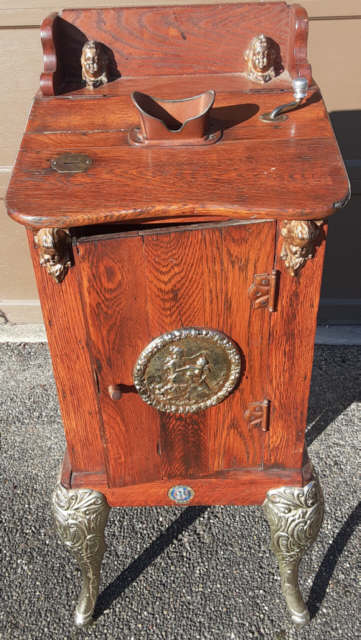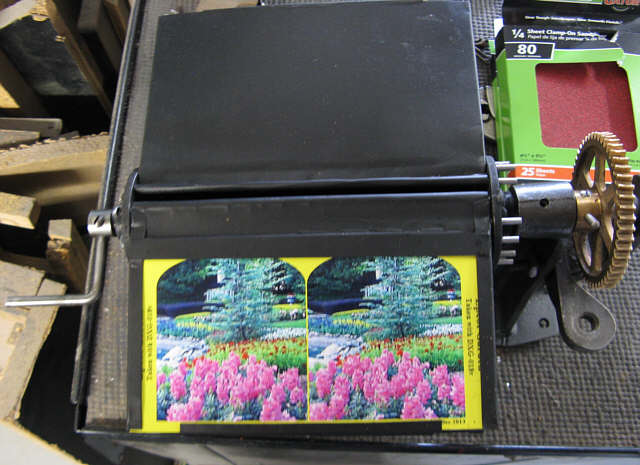1920's Bennett Automatic
Machine Company Drop Card Viewer
With Top Cabinet Crank

Here as purchased. This is a very rare drop card machine.
As of now no other example has been found of this configuration.
It was altered after it was built by Bennett or others, unknown at this time.
It has a Caille sticker on it but it is not a Caille Bros.machine but a machine made by George W. Bennett.
Original parts needed- name plate & marquee frame
If not found replicas will be made
If your reading this and have seen another example or own one - Email me.
There is a motorized version which looks almost identical except the cabinet is taller and has an electric motor in it's base, no crank, and has a different coin entry.
Email contact

The restoration of this will include new plating on all metal trim , cabinet repair, mechanical / electrical restoration.

The viewer has been disassembled and evaluated. I have determined that it started life as a motorized machine.
At some point in it's history a change was made. It was converted from a 3D viewer to a straight viewer by exchanging the dual
wedge shaped lenses and their associated mounted with a single magnifying lens to view Civil War drawings from a book
It turns out that the first page of the set is a partial book cover from a book published in 1881, however the remaining images turn out to be
from a another source yet to be determined, I assume another book sacrificed to make this card set, some time after the early 70's
To complete the transformation the motor and drive shaft were exchanged for a manual crank and new drive shaft protruding from the top deck.
Finally the coin system was disabled , removing the coin tube and knife switch and it was rewired to be powered as soon as plugged in.
I may choose to retain the manual operation or not. Some of this depends if I can locate or can make the parts needed to restore it to motorized.
When motorized, once activated it would run through all 15 photos before returning to the start and standby.
Some of the trim pieces have been "flashed" in gold. This will be removed.
The "U" shaped wood mounted where the marquee frame should be will be discarded. A new frame will be constructed to replace it.
That frame mounts to the 2 cherub castings on the top back deck, which have tapped threads for the bolts that hold it.
.
Restoration of the Mechanism
Below is an image of the Mechanism in the cabinet as purchased.

As can be seen above the machine has been configured to display the history of the Civil War.
The first frame taken from a late 1800's book on the Civil War.
The rest of the images origins is unknown at this time.
Possibly it was setup as a display machine in a museum?



It is a record album from 1972, so this card set could not have been created before that time.
So, it can be assumed the alteration to the Bennett machine took place sometime after 1972

Here new 1/8" steel rods have replaced badly rusted originals, the drive gear has been cleaned and polished along with the drive shaft and activating arm..

Here it's basically finished. It's missing a cap for the side switch activation arm, the cap is used to insulate the mechanism from power
That arm being insulated is very important without it the mechanism would be connected to one side of the line after the knife switch is disabled.
The manual crank handle is in direct contact with the metal of the mechanism. If the machine was automatic driven by a motor it would not be so critical
Based on information from a number of other Bennett owners I have been able to restore the knife switch assy.
A photo later. To explain how this functions as far as power is concerned is a little confusing.
I'll try here. When a coin is dropped into the coin chute it hits a paddle that is part of a weighted "see-saw", the opposite side
of which is holding a knife switch open when in standby. Once a coin hits the paddle it causes the other end of the arm to go up
That motion releases the knife switch and it closes. In the case of this drop card, it will turn the light on and allow the images to be viewed.
If this machine had an electric motor, it would activate the motor and start an automatic viewing of the cards.
The second part of the powering sequence is needed to reset the knife switch, that is done by the arm on the end of the mech and a add on to the knife switch that activates another switch mounted on the cabinet side wall to continue to supply power until the show is over. When the last card is viewed the side wall switch is off and the knife switch has been reset and is being held up by the coin mechanism waiting for a coin to drop on the paddle again.


As received on the left, as it stands now
New oak trim replaces the badly damaged bottom trim, not very evident in the left photo. Note the tops of those boards are cut at a 15 degree angle.
The rest of the metal parts on the outside of the cabinet besides the door emblem and legs have been sent out for nickel plating
The top and door were disassembled and then re-glued and repaired before refinishing
All the internal parts and wiring still to be done The marquee frame still to be created and installed.
A new lock has been found, thanks Joe for your help getting it

Here a new marquee frame has been created, the cabinet is restored.
This not possible without the help from, Stewart H., Brian N. and Joe K.
I will include a few more photos when time permits.
If someone out there has spare parts for one of these, let me know.
I would consider restoring it to automatic operation if the missing parts could be found to do that.
Meanwhile it remains a one of a kind, at least at this point in time.